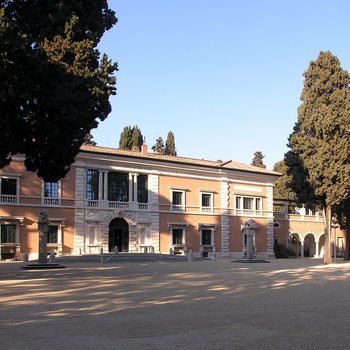I once opened the kiln after a firing and seemed to be looking into the engine room of a time machine. Neither past nor future were permitted there. The stones lay there in slumber. All of a sudden, the space behind them opened up and I gazed into the vast expanse of eternity. The stones began to move – or had they always been in motion? I couldn’t tell anymore.
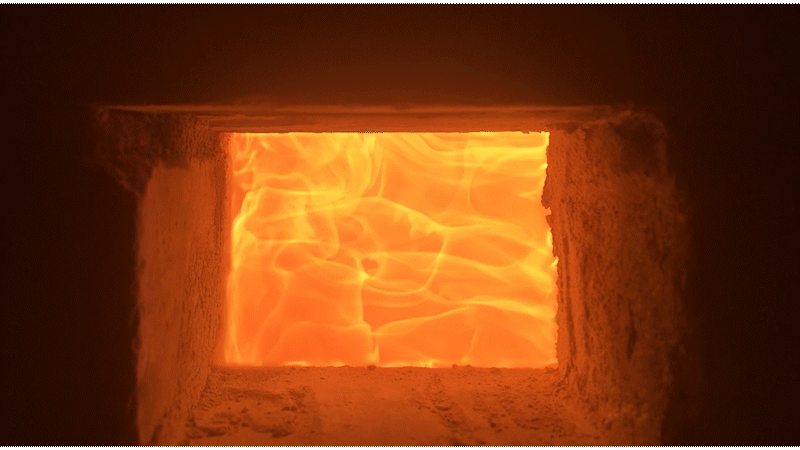
Blick in den Brennofen
© Benedikt Hipp, Loop: Jacob Franke
The firing process lasts for weeks on end. The sourcing and chopping of firewood, the preparation and setting up of the kiln, firing itself, cooling and then, finally, the removal of the finished pieces. When winter sets in and the felling season begins, I buy up logs and branches that are unsuitable for use as building timber. They then need to be sorted into different types of wood, cut to length and then chopped into manageable pieces. This is a physically strenuous process that takes place in various phases over the course of the year. I need around 6 steres of wood for each firing (a stere being a cubic metre of chopped and stacked wood). Working with clay is also highly physical. When my hand presses against the clay, the latter gives way to the pressure. It reacts to my body and follows my movements. If I am hasty and impatient, then so too is the clay. As the majority of my ceramics are hollow, my hands are both inside and outside of them as I form them. I therefore create something that is both around me and comes from inside of me. As such, each ceramic is like a cast of my body. In its raw form clay is very inert, almost sluggish, and exhibits a particular set of physical properties, but once it has been fired it changes its characteristics. If I press against a fired ceramic it is my body that gives way. A broken edge can even be as sharp as a knife, as the clay has swapped its inertia and sluggishness for keenness.
It took millions of years for motion and time to grind stone down to form the fine material we refer to as clay. Firing causes that material to cluster, releasing water and reducing the space between particles. All of a sudden it forms a new conglomeration. It is given form and a life span – neither of which is known to me when I close the kiln. It is as if the fine particles of the clay carry the entire universe within them. The material has been brought into a form that will last for a period that is longer than we can even comprehend. A form that will one day disintegrate back into the finest of particles. It is with this in mind that I like to refer to my ceramics as “stones”, as they are more similar in character to stones than any other object or material. Sometimes they resemble organs or human body parts, which creates a closer bond between us. Can the same happen with stones?
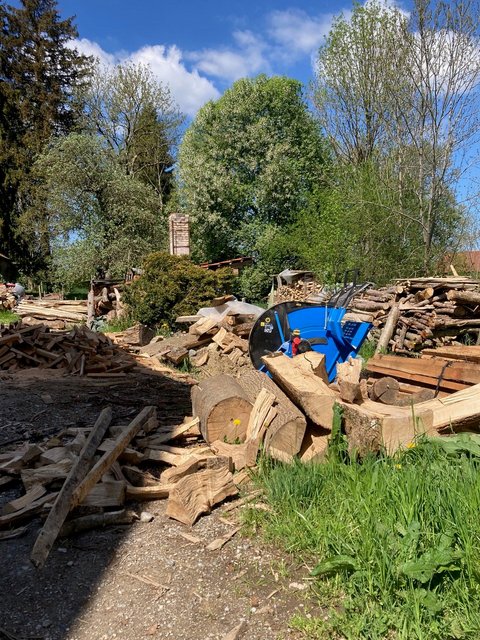
Holzstapel im Garten mit dem Brennofen im Hintergrund
© Benedikt Hipp
Wherever I go, I am always eager to dig up clay and take it with me. There is therefore always a spade and plenty of plastic bags in the back of my car. We might regard them as clays from Greece, Italy or Eastern Germany, but from the perspective of the earth itself they are just earth. I recently found a clay in the forest close to my home that does not retain its form when fired at my usual temperature, and instead begins to melt at around 1200°C. I nevertheless discovered that upon melting it takes on a strange black colour with blueish and whitish patterns in it, which sets it apart from any other clays I have come across. This melted clay forms part of one of my large ceramics on display at this exhibition, and I aim to continue to experiment with it in the future.
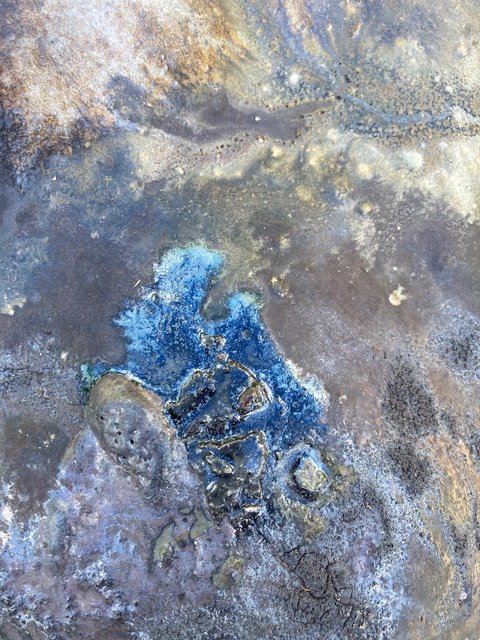
Spuren des Brennprozesses auf der Keramik
© Benedikt Hipp
Once all the unglazed pieces are in position – which, due to the size of my kiln, involves one or two days of crawling around on my knees – I brick up the kiln. Early the next morning I light the fire. The first few hours go by very slowly, and it is vital that the temperature only increases at a low rate. I use this phase to rest or sleep. After twelve hours the kiln reaches around 300°C. The fire is now roaring and requires more attention. As the temperature rises, so too does the intensity of the work required. During the first night I try to take power naps for about 5-10 minutes between stoking phases. Such nights can be very long, and in some cases very lonely. During the early hours of the next day resting is no longer an option, as stoking now demands my full attention and constant monitoring. The temperature has by now reached 600-800°C and I am pretty exhausted, so someone comes to take over while I sleep for a few hours.
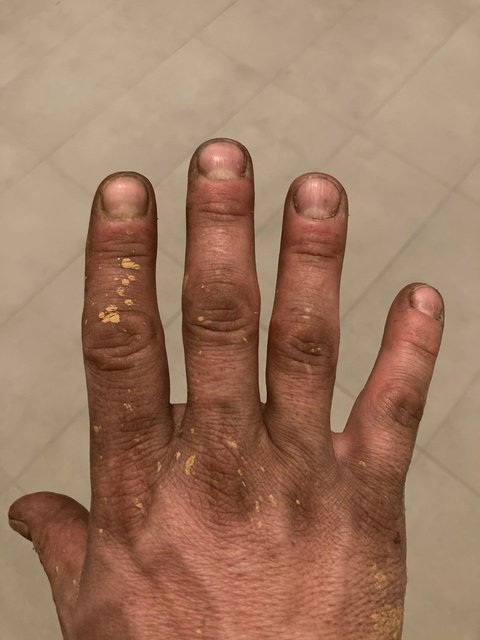
Erde und Hand
© Benedikt Hipp
It is a bit like sailing: You can’t leave the boat, no matter what happens. I have experienced blizzards and thunderstorms, heatwaves and seemingly never-ending rain. Everything that happens influences the firing process. Each and every firing is therefore a unique, never-to-be-repeated event. It is as if the fire documents occurrences and time on the ceramics, similar to the annual rings of a tree.
When I work with clay it is in direct contact with my body, just as there is a direct connection between my body and my paintings when I paint. Both processes cause me to think about this relationship. What is the relationship, what are the threads between my body, our bodies and other bodies? What is our relationship to the world? The last couple of years have shown us just how delicate we are, both as individuals and as a society. A small change to the system can result in dramatic consequences that not only lead to a tidal wave of knock-on changes, but also require us to change ourselves. A renowned brain researcher once said that the brain does not want to change. On the contrary, once it has made itself comfortable it wants nothing more than to be left alone to float lazily in its fluid. Given the global challenges we are faced with, I have to ask myself which transformation is required in order to free us from our lethargy? Or would such a transformation contradict human behaviour?
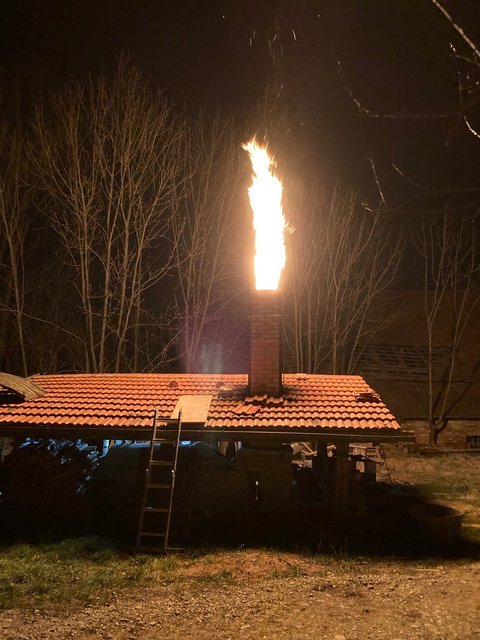
Brennofen mit Flamme
© Benedikt Hipp
By the time the temperature reaches around 850°C all transformative processes within the clay have been completed. Molecular changes to quartz and cristobalite have occurred and the clay has gone through a change of state. I use the morning to get a few hours’ sleep before returning to the kiln for my next stoking shift. Each cycle of heating raises the temperature, and after around 30 hours I have reached over 1000°C. At around 1150°C the ash from the burnt wood that has settled on the ceramics over the past day and a half becomes sticky and begins to melt. Under the influence of the heat from the fire, the clay and ash slowly begin to determine the colour and texture of the ceramic surfaces. In the hours that follow the temperature oscillates between 1200°C and 1330°C, with the ash beginning to trickle down like honey in some places. Each time I open the kiln door to throw in more wood I am hit by an enormous wave of heat. Sometimes two of us throw a large amount of wood into the kiln and it hisses like water does when tipped into hot fat. A 2-3 metre flame shoots out of the chimney, and the kiln resembles a glowing red gnome’s hat.
Two mirrors enable me to monitor the chimney and the flame shooting out of it without leaving my position by the kiln. The flame provides me with insights into the fire inside and the current phase in the heating cycle. By adjusting my firing parameters I can exert a certain influence on the oxidation and reduction processes within the kiln. There are nevertheless other factors that are, by their very nature, beyond my control – for example wind, precipitation, moisture and so on. I therefore have to learn to completely let go of any ideas of what the objects I place in the kiln should or could become. As I said, some parameters can be controlled up to a point, but the interplay between all contributing factors is so complex that it is impossible to predict exactly what will happen during firing. This seems very anachronistic when compared with the technologies we use today, which reliably produce exactly what we want them to time and time again. It is also a far cry from our modern world filled with apps and gadgets, the majority of which are designed to give us a sense of control over our lives and actions.
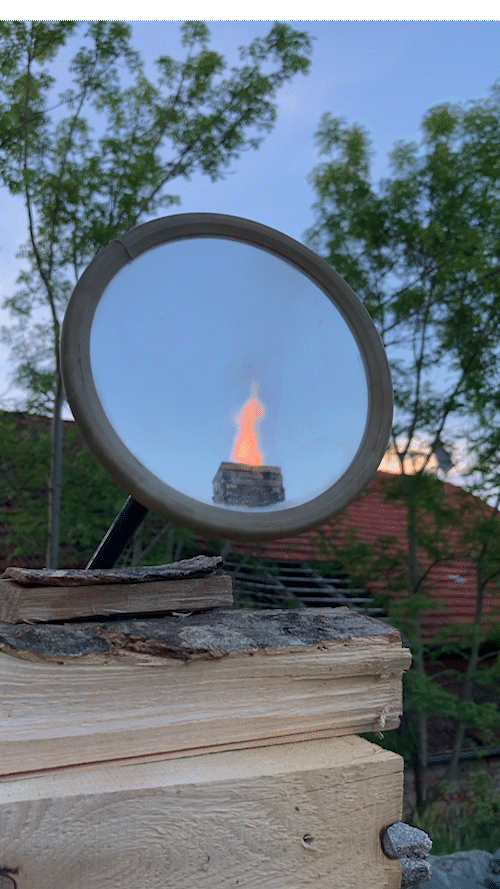
Lodernde Flamme des Brennofens im Spiegel
© Benedikt Hipp, Loop: Jacob Franke
The interplay between my firing technique, external factors and the peculiarities of fire leads to a result that is shrouded in uncertainty right from the outset. It is therefore essential that I trust in my own actions, even though I am sometimes petrified by the high temperatures involved. It seems to me that there is more to it all than just the fired pieces and the theatre of the fire. The fire stirs something much deeper than that. As the firing process reaches its climax, the ceramics and the entire inside of the kiln glow in a whitish yellow that is blinding to the human eye. Yet standing at a distance, or wearing a pair of welder’s goggles, I can use the few seconds I have between each heating cycle to look inside the kiln. It is as if I am looking into another world. Completely unexpectedly the flames roam slowly between the glowing ceramics, lending the scene a semblance of total peace and infinite tranquillity. There is something prenatal about it, like a recollection of a time of which one has no cognitive memory. A return to a time before time.
At some point the moment comes for me to bring the firing to a close. I generally base my decision on the progress indicated by the shimmering melt on the surface and the drips and streaks on the ceramics. Sometimes I feel the time is right after 40 hours, but I have also fired for over 60 hours. It is not unusual for my own exhaustion to signal that it is time to initiate the long final phase of the firing process. I then close all openings to the kiln, the fire inside it goes out, and then, after days of hearing nothing but the crackling and sputtering of the fire, I am suddenly surrounded by complete silence. It takes a few days for the kiln to cool down to a temperature at which I can break open the bricked-up opening and take a first look inside. The stones lie there in slumber. Then, all of a sudden, the space behind them opens up and I gaze into the vast expanse of eternity. The stones begin to move – or have they always been in motion? I can’t tell anymore.
Also of interest:
Though Everything Is Over
Quotes from four passages of the novel Obwohl alles vorbei ist (Though Everything Is Over), published in spring 2023, can be read on posters around Dresden. This intervention by the writer Franziska Gerstenberg is part of the exhibition “Eppur si muove – And yet it moves”.

Villa Massimo – The German Academy in Rome
Every year, the German Academy Rome Villa Massimo awards the Rome Prize to nine selected artists, enabling them to spend ten months in Rome. The artists' works from the last two years are on display this year in the exhibition "Eppur Si Muove - Und sie bewegt sich doch" ("And Yet She Moves") at the Japanisches Palais. Angela Windholz introduces the house and its program.
